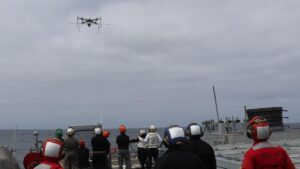Naval Air Systems Command (NAVAIR) issued a Request for Information (RFI) for industry information on potential sources for a short range Vertical Takeoff and Landing (VTOL)-capable Unmanned Aircraft System (UAS) for the Navy’s Expeditionary Forces.
The notice said it is aiming for a solution that is man-packable, battery powered, has a total takeoff weight of up to five pounds, range of up to five kilometers/3.1 miles, has an operating ceiling attitude of over 10,000 feet and endurance of over 30 minutes, is rugged and ready to use as delivered with minimal logistics, training and support requirements.

Program Executive Office for Unmanned Aviation and Strike Weapons’ Navy and Marine Corps Small Tactical Unmanned Aircraft Systems Program (PMA-263) is to office managing this RFI.
The Navy said the UAS should provide real-time full motion video via electro-optical and/or infrared (EO/IR) sensors and capable of autonomous or safe manual launch with minimal support equipment from a small, confirmed area. The vehicle is expected to land either autonomously or manually within a designated area as well.
The UAS recovery method is also expected to prevent system damage and allow short turnaround times between missions.
NAVAIR wants the vehicle to be able to support operations like “mission planning, reconnaissance, surveillance and target acquisition, patrolling, security/force protection operations, convoy operations, and military operations in urban terrain under all environmental conditions, both day and night.”
Notably, the Navy is seeking detailed information in response to a series of questions which include if the system can navigate without GPS, if it can safely land in water, what payloads are available or in development, does the system support third party payloads, and what is the production lead-time for single order quantities running from 1-250 systems and 251 to 500 systems. The Navy defines a system here as two air vehicles and one ground station.
The questionnaire is also interested in the current maximum production output at one, two, and three shifts per day and estimated unit cost for each full system.
Responses are due by Feb. 16.